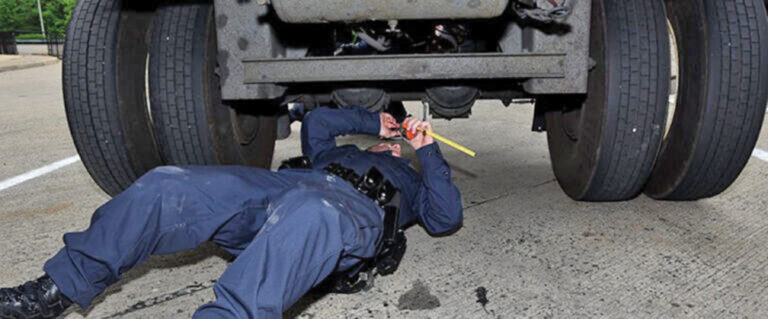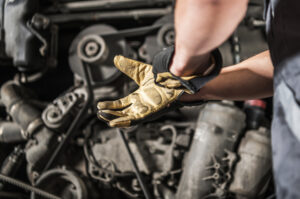AVON, Ohio — In trucking, as in life, there’s no substitute for being prepared — whether it’s the next load, storm or inspection.
And inspections are top of mind right now in the North American commercial vehicle industry, as one of the biggest touchpoints on the calendar is now here: Brake Safety Week, happening Aug. 21-27.
The annual event run by the Commercial Vehicle Safety Alliance (CMVSA) examines commercial vehicles across the United States, Canada and Mexico.
To help drivers prepare, the team at Bendix Commercial Vehicle Systems LLC is offering some suggestions.
“During last year’s CVSA Brake Safety Week, 12% of the 35,764 vehicles inspected were placed out of service for brake-related issues,” Fred Andersky, Bendix director of demos, sales, and service training, said. “So many aspects of safe vehicle operation are directly impacted by what goes on at the wheel-ends and in the braking system that you really can’t overstate the importance of keeping up with maintenance and inspection of those areas. From stopping power to the performance of higher-level technologies like collision mitigation, everything is linked to how well the brakes and wheel-ends perform when they’re needed. That’s why these inspections matter so much, and why Bendix puts the word out with practical tips for being prepared and staying safe.”
Brake Safety Week is part of CVSA’s Operation Airbrake initiative, an outreach and enforcement campaign that aims to reduce the number of highway crashes caused by faulty brake systems on commercial motor vehicles. The event involves local, state, provincial, territorial and federal motor carrier safety officials in the United States, Canada and Mexico inspecting large trucks and buses, focusing on brake system violations.
What to expect
Brake Safety Week roadside inspectors conduct North American Standard Inspections, which cover a range of driver qualifications, documentation and vehicle equipment conditions.
They’ll be checking for:
- Missing, nonfunctioning, loose, contaminated, or cracked parts.
- Holes caused by rust and through rubbing or friction.
- Broken springs in the spring brake housing section of the parking brake.
- Air leaks around brake components and lines.
- Air pressure in the target range of 90-100 psi.
- Slack adjusters not at the same length.
- Mismatched air chamber sizes across axles.
- Warning device functionality (such as antilock braking system indicator lights).
Inspectors will also look for brake hose and tubing chafing violations — the focus of this year’s Brake Safety Week.
How to get ready
“Pre-trip, post-trip and regular inspections can go a long way toward catching some obvious violations, including loose hoses or damaged components like air chambers or pushrods,” Mark Holley, Bendix director of marketing and customer solutions at Wheel-End, said.
He recommends the following:
Every day
- Check for damaged or loose-hanging air chambers, pushrods, or slack adjusters.
- Make sure slack adjusters on each axle are extended out to the same angle. Different angles can indicate an out-of-adjustment brake or a broken spring brake power spring.
- Examine tubing and hose condition, positioning, and connections.
Every week
- Perform a 90- to 100-psi brake application with the wheels chocked and the parking brakes released, and listen for leaks.
- Check air disc brake rotors for cracks.
- Inspect drum brake linings for wear and cracks.
Every month:
- Check for moisture in the air system to prevent contamination that leads to component deterioration and system leaks.
“It’s also worth greasing the S-cam brake tubes and automatic slack adjusters any time you’ve got a vehicle in the shop,” Holley said. “This quick process helps prevent rust and corrosion and helps keep the slack functioning properly.”
Regarding brake hose and tubing chafing, Bendix recommends watching for two typical causes. First is improper routing and clipping, which can cause hoses to rub together while the vehicle is operating. Preventive measures include periodic inspections to ensure tie straps, clips and any brackets are not damaged or broken.
The second typical cause is improper hose length — an overly long replacement hose is susceptible to chafing.
Damaged hoses should be replaced.
“In addition, from the larger perspective, never underestimate the significance of communication between drivers and technicians,” Andersky said. “A driver out on the road may be the first one to notice an issue with the truck. Being able to tell the technician what happened, where, and other details such as weather conditions is important – as is the technician asking questions to get a clearer understanding of the situation.”
Andersky said this is all part of the holistic approach to upkeep, which is critical when considering the complex interconnectivity of the entire brake system and more advanced safety technologies.
“Any sign of something out of compliance can indicate wider maintenance issues,” Andersky said. “Meaning that, taken individually, things like an active full-stability light on the dash or a kink in an air hose – and everything else inspectors are looking for – are of consequence.”
How drums and discs differ
Where Brake Safety Week is concerned, air disc brakes and drum brakes have a few differing maintenance needs.
“Key among the differences is the measurement of brake stroke,” Holley said. “Because air disc brakes include an internal adjustment mechanism, their brake stroke is not measured externally, as is the case with drum brakes. The internal adjustment mechanism significantly lowers the risk of out-of-adjustment violations.”
Measuring a drum brake’s chamber stroke is a matter of checking the distance from the air chamber to the clevis pin with the brakes released, and then again after a fully charged brake application. The difference between these is the brake stroke, and its maximum length depends upon the brake chamber type and size.
Improperly adjusted brakes can also drag — impacting fuel efficiency and speeding up pad wear — or experience decreased stopping power. Bendix has developed an infographic (included below and attached) to note the differing maintenance needs of air disc and drum brakes.
Select the right parts
If you notice it’s time for new brake friction, make sure to keep things up to spec: Not all friction that is marketed as “acceptable” under current reduced stopping distance (RSD) regulations will actually perform to that standard. Whether you’re replacing air disc brake pads or drum brake shoes, select components that will ensure the original equipment manufacturer (OEM) requirements are met, so that the vehicle remains compliant.
“The aftermarket is more crowded than ever, particularly when it comes to brake friction,” Holley said. “The wrong choice can harm your system and undermine vehicle safety. Complications arising from improper friction selection can include cracks, degradation of braking performance or damage to other wheel-end components. Remember, these are things that a roadside inspector will note and penalize you for.”
When it comes to remanufactured drum brake shoes, ask your supplier whether they have been coined back to their OEM-engineered shape, and not simply relined with new friction, Holley noted. Shoes become misshapen under the stress of regular use and relining one of these without returning it to its original geometry can impact stopping power and friction life.
You’ll also want to protect the air supply against corrosive oil aerosols that lead to leaks and potential violations.
Bendix recommends using an oil-coalescing air dryer cartridges, which can be used to replace standard cartridges.
However, the reverse is not the case: You shouldn’t downgrade from an oil-coalescing cartridge to a standard.
The Trucker News Staff produces engaging content for not only TheTrucker.com, but also The Trucker Newspaper, which has been serving the trucking industry for more than 30 years. With a focus on drivers, the Trucker News Staff aims to provide relevant, objective content pertaining to the trucking segment of the transportation industry. The Trucker News Staff is based in Little Rock, Arkansas.














